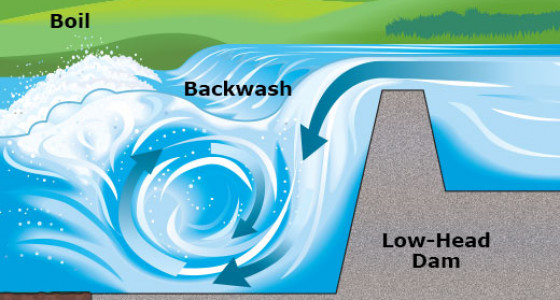
“Montana Rivers are not theme parks” says George Corn, the former Ravalli County Attorney, who challenged FWP over their closure, this spring, of the Bitterroot River between Woodside access and Tucker access. In question was the danger created when river users, intentionally or otherwise, attempt to run a boat over the low-head dam that exists in this stretch of river. As the public begins to recreate in earnest on local rivers it might be of some use to understand what makes these types of dams so dangerous. There are many low-head dams on rivers across Montana. They have been dubbed “drowning machines” or “killer dams” in boating classes for decades. The sheer drop caused by this type of dam construction creates a reversal or “boil line” in the river that can recirculate objects, or people for long periods of time. The upstream currents are strong enough to pull a sturdy raft backwards or upriver and capsize it into the recirculation. This feature can also occur naturally on rivers with large rocks or rock ledges. Whitewater boaters generally refer to these as “hydraulics” or “keepers”. This type of whitewater feature would be different from a “hole” or large wave. The naturally occurring hydraulics can be easier to escape because they do not stretch across the entire river like a low-head dam; thus allowing a chance to get out on one side or the other. A well-known natural hydraulic that does nearly span the entire river is Velvet Falls on the Middle Fork of the Salmon. Most boaters choose to run Velvet on the left side where there is a break in the ledge. Low head dams are deceptive. We generally think the size of a wave or a hole and its height indicates danger level. The larger the feature; the more dangerous it is. Not so with hydraulics. Flat boil lines indicate more danger. All the water and energy in the feature is being recirculated in the river; there is little or no whitewater bouncing around. Lots of wave action and bouncy-type whitewater indicates there is water flushing downstream. Flat boil lines and flat horizon lines indicate full recirculation and dangerous hydraulics. Looking downstream, low-head dams and large drops in a river will appear as a flat horizon line (the river disappears). It’s always a good idea to scout downstream if you’re not intimate with the river and this is the visual you have. Seasoned river runners can sometimes be led astray by the seemingly flat water in the boil line. I’ve heard more than one story of river runners with experience, hoping to avoid a portage, attempting to run low head dams and paying the price. It was rumored a group of boaters, that had trouble on the controversial section of the Bitterroot this spring, ran the feature intentionally. The boil line looked innocuous enough that this group decided to give it a go; with bad results. Low-head dams were created to divert water, generally for irrigation. They are a relatively inexpensive way to accomplish diversion. Pennsylvania has more than 2000 of them and; their Fish and Game Department feels they are the number one reason for river fatalities in that state. River sections with low-head dams can be run safely. For the vast majority of situations the dams should be portaged. We need to be river wise enough to recognize the hazard and have the necessary skills to hit the portage. Perhaps an adjustment in our attitude about the dangers of moving water is in order. It is irresponsible to run a river without the necessary skills to maneuver and hit a landing spot or make an eddy turn to stop your downstream progress. The most important skill for a river runner is being able to put on the brakes and get out of the current. The use of the term “floating” for going down a river has always bothered me. Floating connotes a passive, submissive approach to recreating on the river. “Running” a river sounds like you’re going to use river tactics like back ferries, and river features like eddies, to work with the current and control your experience. You see people going down a river and it looks so great and restful it’s easy to think boating comes naturally; that we are born with the ability to row a raft and fish. If you are a novice boater consider taking a boating class or a river safety class. Perhaps you can find a river veteran to teach you some skills. There is plenty of information on the web. Though not river specific, www.boat-ed.com addresses boating safety in Montana. Other sources include the American Canoe Association, the American Whitewater Association and your local boat shops. Think about it before you go on a river or take your kids on a river. George Corn is exactly right, rivers are not theme parks; there are inherent dangers associated with recreating on moving water; not the least of which are the lurking low-head dams. These hazards can be negotiated safely, but there is a learning curve.